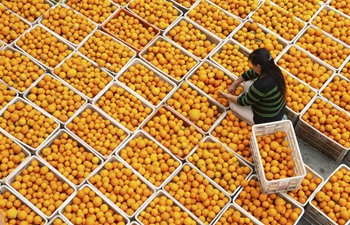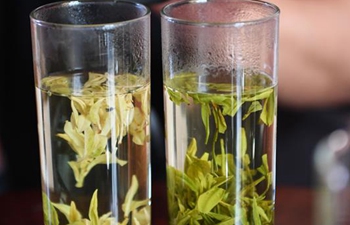by Ndalimpinga Iita
WINDHOEK, April 10 (Xinhua) -- Prolonged dry spell coupled with an economic downturn is stifling traditional food sellers' trade in Namibia, causing a fall in their income.
Over a decade, Anelly Sheehama from the Oshana region in northern Namibia sold preserved and dried traditional food items at a local open market. Since 2017, however, the food seller witnessed a downturn in the business.
Traditional food including jackal berries, buffalo thorn fruits, baobab fruits, mopane worms, and spinach are in short supply. They have been a significant source of her income, according to Sheehama.
"Due to the dry spell, the indigenous fruits barely ripen, reducing my supply of stock collected and likewise income stream," she said on Tuesday.
Namibia has since 2013 been affected by a drought, which harms some 60 percent of the households dependant on crop farming and agriculture.
Paul Natanael, an agricultural scientist, said poor rainfall has affected seed generation and reproduction in the northern region, lessening agricultural output.
Meanwhile, the consumers' purchasing power declined significantly due to a weakened economy.
According to the World Bank, the southwest African country's economy slowed down considerably in 2016, registering a modest growth of 1.2 percent, compared to an average rate of more than 5 percent in each of the previous five years.
Traders are feeling the pain. "Customers no longer purchase regularly as before, nor do they buy in substantial amounts. Survival is harder for us," Sheehama said.
"Until two years ago, one could generate up to 500 Namibian dollars (35 U.S. dollars) or more in a day. But now, a day can go by without making a sale or client calling; now I make only up to 650 Namibian dollars (46 U.S. dollars) a week or fortnightly," she said.
Another vendor, Penina Andreas said there has also been a shift in commodity demand.
"Customers would rather buy pearl millet or animal feed, but sold at a reduced price. We are truly facing hard times," Andreas said.
While some vendors relinquish their market stalls, Sheehama is not giving up. "I came to the open market to do business, and I have six children to feed," she said.
To stay afloat, some vendors have raised the price of goods including spinach and mopane worms. Andreas said, "I had to double the price of the 330 ml content from 10 Namibian dollars (0.7 U.S. dollars) to 17 Namibian dollars (1.2 U.S. dollars)."
In the dry spell, vendors have also had to source from other regions. "We organize ourselves to reduce transport cost," Andreas added.
The Bank of Namibia, in its latest economic outlook report, for December 2018, said Namibia's economy remains weak and is expected to recover gradually in the medium term, and "Growth for the agricultural sector is expected to stabilize around 4 percent in 2019 and 2020."













